Death of the Reprobate review - a devilishly good romp through living paintings
Fine art.
I will never forget the day my uncle told me about his neighbour's cat Malcolm. Partly because my family always manage to crowbar it into conversation somehow whenever we get together, but mostly because Malcolm is indeed, by all accounts, a bit of a shit (pardon the swear). Every day, he'd waltz through my uncle's cat flap, gobble up the two lots of food he'd put down for his own pair of scaredy-cats, then turn around and promptly leave again. Certain retellings sometimes have him peeing on the mat. Others, puking his guts up.
I was reminded of Malcolm this week playing Joe Richardson's latest Renaissance-painting-come-to-life adventure game Death of the Reprobate. In it, you also play a bloke called Malcolm the Shit, and I reckon they'd get along famously. Within seconds of starting, you get to see precisely how Malcolm earned his obnoxious suffix as he doles out all manner of terrible punishments on petty criminals who have dared to upset him. As they're wheelbarrowed into his throne room, Death of the Reprobate's over the top dialogue immediately sets the tone for what's about to follow, and when a messenger arrives saying your father, John the Immortal, isn't living up to his name after all, off you trot to visit him and hopefully claim your inheritance before he pops his clogs.
But like father like son, old John knows what a stinking turd of a man Malcolm's become back at court, and tasks him with performing seven good deeds before sundown to prove he's worthy of his earthly riches. 'The Lord will guide you,' you're told ambiguously, which is probably appropriate, given the period and all, but then you step outside and find 'The Lord' quite literally standing across from you in the bushes, holding a big pointy sign above the head of your first, unwitting quarry. I guess The Lord works in mysterious ways after all, it seems.
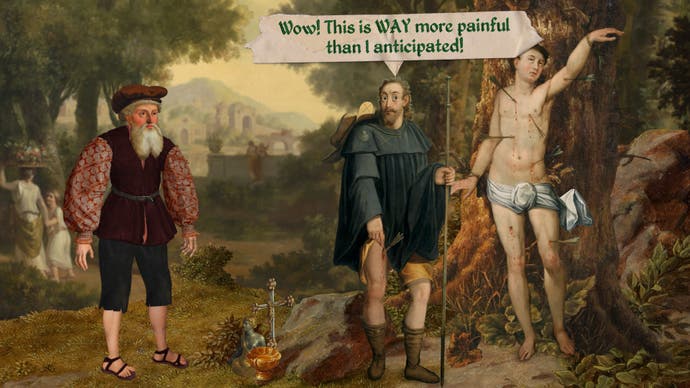
Thus begins your droll point and click odyssey to help seven local peasants in the nearby backwater, with each one requiring their own unique cocktail of fetch quests and puzzle items to acquire before you can cross them off your to-do list and consider the deed done. It's classic adventure game fare, in other words, albeit presented through the lens of comically repurposed real-life paintings, with characters, scenes and landscapes all thrown together to create a surreal, but always entertaining village of miscreants.
If you've played Richardson's most recent work, The Procession to Calvary, you'll know exactly what kind of farcical nonsense to expect here. But for those who haven't, this is art as you've probably never seen it before - think Pentiment or Please, Touch the Artwork at their naughtiest and most irreverent, and then keep dialling it up to 11. Jauntily animated and armed with modern, whip-smart quips and barbs with which to berate you, its wonderful mishmash of figures from across the Renaissance, Baroque, Classical and Pre-Raphaelite periods have rarely felt more alive or enjoyable to behold and have a chinwag with.
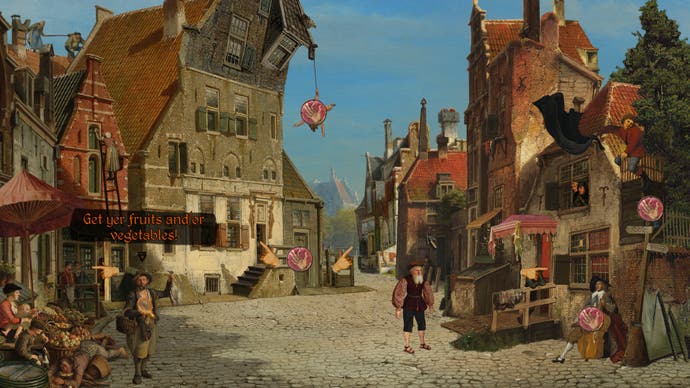
Richardson has such a keen eye for wit and just patently daft exchanges between these famous faces that every tableau is just a pure delight everywhere you look. Even across just a handful of playable scenes, he manages to capture the full spectrum of the human experience, from quarrelling saints and well-to-do families under siege from their throngs of children, to drunkards endlessly pissing into bottles in the local tavern while their mates bet on monkeys throwing dice in the corner. It does always tend to lean into the more sordid corners of that spectrum, mind, but let's face it, when hovering your mouse over a character reveals their name to be just 'Creepy Fop' or 'A Moaning Little Slap-Faced Brat', only those with a heart of stone would be able to resist having a secret little giggle. The music helps a lot with this too, as every room, street and dwelling has its own accompanying chorus of chamber musicians tootling away in the background, regaling you with the likes of Mozart, Bach, Chopin and others. It's really very charming in how it mixes low and high brow together like this, and it creates a powerful sense of place that permeates the game from start to finish.
Against this preposterous backdrop, Malcolm must commence his do-gooding. He has three available actions he can perform on any interactable object: look, speak and touch (though the latter usually results in slapping some poor soul in the face, or if he's feeling particularly generous, a good little scratch on the head). You'll have to use a combination of all three to puzzle your way to victory, and many involve a good degree of creative thinking to achieve the right results - just wait until you get to the cow and the bucket, is all I'm saying. If you do get stuck, though, Death of the Reprobate doesn't beat around the bush when it comes to hints and tips on how to proceed. A very straight-talking mystic will tell you quite plainly what you need to do next to help someone out, and while I wish it wasn't quite so blunt during those initial enquiries, there is something to be said for how it respects your time and patience levels (although when you can see the whole thing in just under three hours, speed isn't exactly of the essence here either).
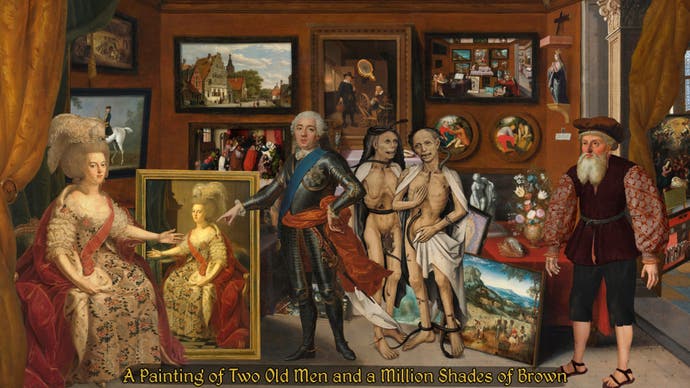
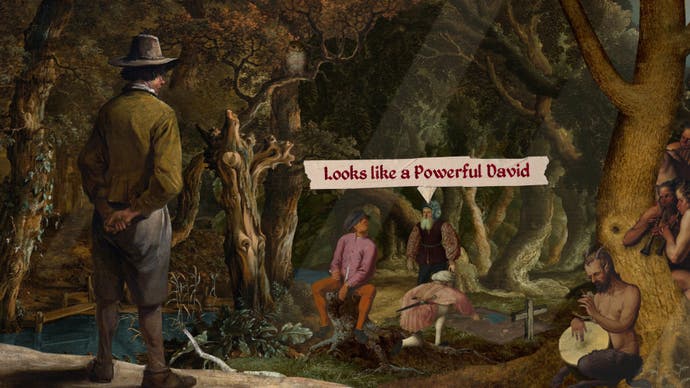
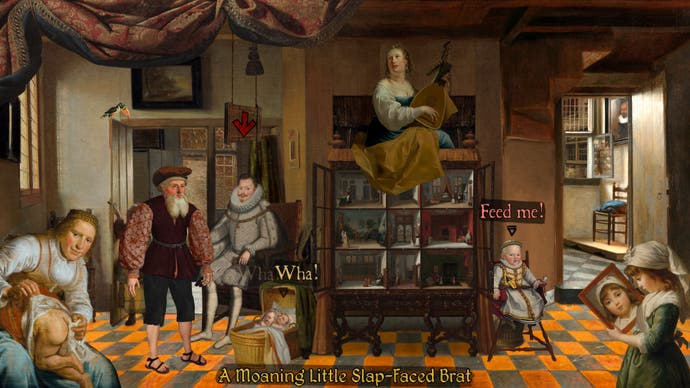
Admittedly, most of the times I got stumped was because I hadn't even realised I'd missed a vital clickable object, as due to the nature of its artfully constructed brushwork, it can sometimes be hard to work out what's just part of the background and what isn't. I also started playing this on my Steam Deck, which forces you into using its slightly arduous touchpad by default, and whose small screen makes it even more challenging to pick out tiny details like this. Moving to my desktop, I had a much easier time of it, if only because I had an actual mouse and keyboard to hand so I could press H or hold my middle mouse button down to highlight every interactive object in any given scene. This still didn't solve all my problems, though, and one particular puzzle in the tavern had me repeatedly glossing over important clues because my eyes simply didn't register some very subtle character changes. I won't lie, I felt like a dunce once I'd actually figured it out, but just occasionally, the whole living painting look can work against its otherwise excellent puzzles.
My only other concern is that its script leans a little too heavily on current meme culture for my liking, and I worry whether it's got the stuff to truly stand the test of time further down the line. There are moments that go FULL?CLAPPING?HANDS?EMOJI?, for example, while others resort to text-based emoticons like :P and ;). Sure, they resonate now, but will they seem quite as cute in five years' time? Ask me again in 2029 when my 40-something cringe-ometer will be well and truly in its element. But even in the here and now, some lines of dialogue can verge on being a bit too meme-y already, so if your tolerance for things like "Get rekt!" is quite low, Reprobate probably isn't the game for you.
Still, even if its dialogue isn't always to your taste, Death of the Reprobate is so winning nearly everywhere else that it makes it that much easier to forgive the odd clunker. Its bawdy and playful quests are infectiously cheeky, and its smartly constructed puzzles will leave you wishing there were more unfortunates in need of Malcolm's assistance. In times when you need a bit of a laugh, Death of the Reprobate is probably one of the best remedies there is right now, and - just like my uncle's Malcolm the cat anecdote - it's easily one of the most memorable games I've played all year. Let the campaign to canonise Malcolm the Shit start here, because this is really quite heavenly.
A copy of Death of the Reprobate was provided for review by developer Joe Richardson.

